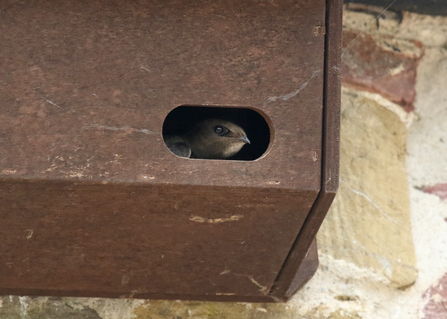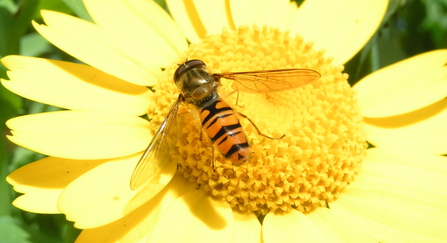
Common swift in nest box by Vaughn Matthews
A bumble bee forages on a sunflower at Vine House Farm in Lincolnshire. Picture: Matthew Roberts

Common swift in nest box by Vaughn Matthews
On 7 June the world celebrates these incredible high flyers; did you know a swift never touches the ground unless when nesting? They eat, drink, mate, and even sleep in flight!
Celebrate these amazing birds by installing a swift box – at least 3m high – well tucked under a north-facing eave.

Hoverfly on a marigold. Photo by Richard Burkmar
Plant your annual bedding plants to ensure your garden is a picture of colour for the rest of summer. Look out for pollinator-friendly species such as sunflowers, pansies, cosmos, marigolds.
Spring flowering shrubs like forsythia and philadelphus are best pruned straight after flowering to improve shape and flower production.
Buff-tailed bumblebee (Bombus terrestris). Picture: Richard Burkmar
If you see a struggling be on the pavement, dilute some sugar in few drops of water to make a runny paste and offer it to the bee for an immediate boost of energy.
Be careful not to dirty its wings as these need to remain spotless to allow bees to fly. You will see its little feeding trumpet dip eagerly into the mixture; 10 minutes are usually enough to revive most bees.
Never feed bees honey as this can carry deadly viruses which the bees will then in turn take to the hive.

Bug hotel by Tania Malrechauffe
Create a small insect hotel out of bits of deadwood, bark, bamboo canes and pine cones, and place in a sheltered area of your garden. This will encourage beetles and other insects which are the main diet of many endangered creatures such as hedgehogs.
Check in time: Make a bug hotel (https://youtu.be/uyZaCc0Heks)
Check in time: Make a bug hotel
Our wildlife gardening expert Ben has lots of great ideas for making gardens of all sizes a haven for wildlife.